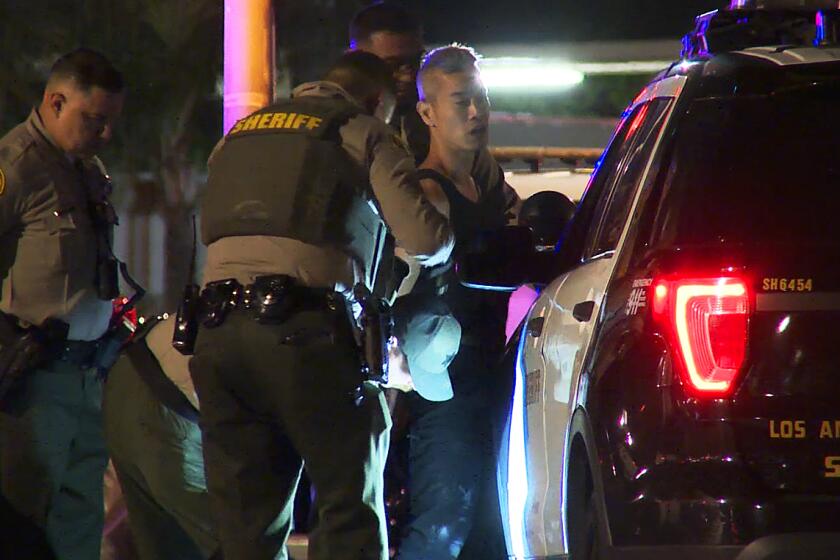Groundbreaking textbook makes the case for reproductive justice field
In Boalt Hall’s faculty lounge the other day, UC Berkeley Law professor Melissa Murray was telling me about some of the cases she and her colleague Kristin Luker included in their groundbreaking legal casebook about reproductive justice.
Of course the book includes benchmark Supreme Court decisions that everyone’s heard of, the ones that struck down laws against abortion, contraception and sodomy. But it also includes less familiar cases, sometimes significant but often overlooked markers — or bumps — on the road to equality.
I’d never heard of Susan Fejes, a Colorado blackjack dealer and new mother who unsuccessfully sued a casino in 1997 because it would not accommodate her lactation schedule.
“There was no place for her to express milk, and the court’s like, ‘There doesn’t need to be!’” said Murray, 39, who was once accused in a Berkeley restaurant of feeding her infant son “poison” because he was drinking from a bottle.
“We may have a culture that prioritizes breast feeding,” she said dryly, “but we don’t have a legal jurisprudence that does.”
Luker, 69, a renowned sociologist and law professor, mentioned the case of a bus driver in rural Texas who was fired in 2010 after refusing to drive two women to a Planned Parenthood clinic. He sued, claiming that he’d been discriminated against based on his religion, settled for $21,000 and, in a victory of sorts for women’s rights, agreed never to work in transit again.
“Cases on Reproductive Rights and Justice,” a 919-page door stopper released in November, is the first legal textbook to focus on sex, marriage, contraception, pregnancy, birth and parenting. The cases, accompanied by essays that provide social context, raise compelling questions about how the state regulates our most intimate lives.
These days, the public square is filled with shouting about abortion, but what about the right to have children? Is it discriminatory for states like California, for instance, to tell mothers on welfare that they will receive no additional help if they have more children?
“Reproductive justice,” Luker said, “suggests that having a baby is just as important as the right not to have a baby.”
Despite an abundance of sex — some judged to be quite perverse — this is not a book your “Fifty Shades of Grey” reader will rush out to buy. (For one thing, it costs $185.)
But its impact, I think, will transcend its target audience.
“The publication of this book signals the legitimacy of the subject matter as an area of study, and also as an area of practice,” said Jill Adams, executive director of Berkeley Law’s Center on Reproductive Rights and Justice, founded by Luker in 2013. “In legal education, these cases and concepts are given very short shrift. It’s a victory to have this subject matter encased in that familiar blue binding on the shelf alongside all the other well-established courses.”
Indeed, Murray and Luker may have done for reproductive justice what Ruth Bader Ginsburg and Berkeley Law professor Herma Hill Kay did for the emerging field of sex discrimination law in 1974, when they wrote the first casebook about it. Or what another Cal law professor, Nancy Lemon, did in 1996 when she wrote the first textbook on domestic violence law.
“It’s not an accident that two women scholars wrote this book,” Luker said. “I always say, this is why the ancients made Cassandra a woman. She foresaw the future and nobody believed her.”
The idea for the book came from Law Students for Reproductive Justice, an Oakland-based national group whose members wanted to move beyond Roe vs. Wade (which legalized abortion in 1973), Griswold vs. Connecticut (which legalized contraception in 1965) and Planned Parenthood vs. Casey (which upheld Roe in 1992 but allowed states to pass restrictions such as waiting periods and parental consent).
Over several years, the students compiled an electronic syllabus, disseminated it to law schools around the country and agitated for more courses.
“There were lots of instructors who were interested in teaching, but the absence of a casebook was a huge deterrent because it means you actually have to compile the materials yourself,” Murray said. “It also suggested that the field was not a field at all because it hadn’t been defined by a book.”
Eight years ago, Adams was the student group’s executive director. She made it her mission to find an author for the project.
“I began cold calling professors around the country,” said Adams, “and they all said the same thing: ‘Whoa, whoa, whoa! Do you know how much work it is to write a casebook?’”
Because of her deep knowledge of the field, Luker was a natural choice, Adams said. They turned to Murray because of her expertise in family law and criminal law, and her focus on the regulation of sex. Their book proposal met no resistance.
“We’re always looking for topics that are not only cutting edge and can sell books, but that are important,” said the textbook’s publisher, Pamela Siege Chandler of Foundation Press. “When we had the opportunity to publish a textbook by some of the leading scholars in the field, it was a pretty easy sell.”
This spring, law schools that offer reproductive justice courses will finally have a textbook to assign.
“Our members are over the moon,” said Sabrina Andrus, current executive director of Law Students for Reproductive Justice. “It’s wonky to get excited about a book, but the issues that will be taught because of this book are revolutionary.”
Twitter: @robinabcarian
More to Read
Start your day right
Sign up for Essential California for news, features and recommendations from the L.A. Times and beyond in your inbox six days a week.
You may occasionally receive promotional content from the Los Angeles Times.







